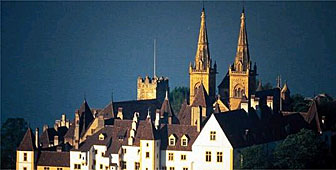Neuchâtel boasts colourful history

Neuchâtel, one of the four host towns of Expo.02, will present its exhibitions and events on a lakeshore that once didn't exist.
What many people who walk, cycle or moor their boats near the lakeshore are not aware of is the fact that barely a century ago, the edge of Neuchâtel sat 500 metres back.
The extra miles that Neuchâtel added to its shoreline – also known as the “jeunes rives” or young shores – is a product of industrial expansion in the canton and the forcing of the local river, Seyon, underground, according to Veronique François of Neuchâtel’s tourist office.
François, who took me on a walking tour of the city, said that in the first records of Neuchâtel, dating to the 10th century, the lake’s waters touched the walls of the city’s hilltop castle, which was built by a king of Burgundy in the 12th century.
She added that much of this expansion process took place mostly in the late 18th to early 19th centuries and involved cutting off and forcing underground the River Seyon, the course of which ran over the city’s hills and through what is now the centre of Neuchatel, before spilling into the lake.
Much of the money for the Neuchâtel’s expansion and the diversion of the Seyon was bequeathed to the city by one of its most famous merchants, David de Pury.
Son of soil
De Pury, who died heirless in 1786, was a real son of the soil, who belonged to a local family of entrepreneurs – most notably his own father, who founded a town along with other Neuchâtelois immigrants, called Purysville – now disappeared – in the American state of South Carolina.
One of Neuchâtel’s main shopping squares, the delta-shaped Place de Pury, is built over the original path of the River Seyon, which was shunted off with the help of the millions inherited from the city’s oldest benefactor.
Butter and ochre
On the far side of the Place de Pury, I began a near perpendicular walk – not for the aerobically challenged – along a cobbled path and stone steps towards the city’s landmark castle, now the seat of the canton’s government.
The castle like several buildings that are typical of Neuchâtel, is a shade of butter though stained with occasional streaks of ochre – a remnant of the fire of 1714 that licked at the monument and the church in its backyard.
One of the castle’s main rooms, the tribunal, has a display of the gilded coats of arms of every ruler of Neuchâtel, beginning from the princes of Burgundy in the 11th century to the last, King Frederic III of Prussia, who was deposed in a bloodless revolution in the 19th century.
My guide told me legend had it that Neuchâtel (meaning “new castle”) was named by its earliest known ruler, Rudolf III of Burgundy, who presented the building, on what was then the town’s lakeside, to his wife, Irmengarde, in the early 11th century.
The Burgundy influence can still be seen in the roof of the church, known as the Collegiale. The tiles of the roof are typical of the French region in that they are glazed and in vibrant hues of orange and green.
Halfway down the street leading away from the castle mount, the architecture of houses sharply changes from the 15th century to the 18th century, because at least 60 of them had to be rebuilt after the fire of 1714.
Lace and watchmakers
I asked François if there was any link between the region’s heyday as a watchmakers’ paradise – now more of a tradition – and the influx of French Protestants, the Huguenots, after the Reformation.
She said the work ethic and the motivation to start a new life which the Huguenots brought with them to the region, created enough enthusiasm to set the wheel of industrial reform rolling through the canton.
Nonetheless, Neuchâtel’s reputation as the hub of technological advances in the 18th century could also be attributed to the reign of the Prussian rulers – the first of whom was given Neuchatel in exchange for renouncing Hanover after being defeated by Napoleon.
François said the seeds of Neuchâtel’s industrial traditions lay in the cottage industries of lace and watch parts.
“In the mountains in the 18th century, villagers were snowed in for about four months of the year, so they had to find some kind of work that they could do inside, that would bring in some revenue.”
Women did lace work and men turned to watch and clock making. The rest is Swiss history.
by MaryAnn Mathew

In compliance with the JTI standards
More: SWI swissinfo.ch certified by the Journalism Trust Initiative
You can find an overview of ongoing debates with our journalists here . Please join us!
If you want to start a conversation about a topic raised in this article or want to report factual errors, email us at english@swissinfo.ch.